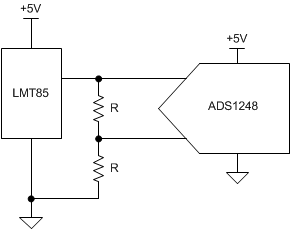Other Parts Discussed in Thread: LMT85, , LMT70, ADS1220, ADS124S08
An ADS1248 design uses an LMT85 as the cold junction sense for thermocouple measurement. The ADS1248 is unipolar supplied. In order to comply with ADS1248 measurement requirements, the signal needs to be 100 mV above AVSS (AVSS + 0.1). Hence,, based upon this and other reading from this Forum, a single ended measurement is not appropriate for this ADC system. Is it acceptable, therefore, to basically lift the ground of the LMT85 by say 200 mV or so and make a differential between LMT85's Vout and the lifted ground? (Basically, what is done when using internal bias to lift the thermocouple leads to mid-supply, but not mid-supply.
If this is a valid method, is using a voltage divider with an op amp buffer to set the 200 mV a good approach? The PGA would be set to 1. All measurements should be ratiometric.
As a curve ball, a TI application report, SNAA267, April, 2015 shows an LMT70 interfaced to an ADS1220, Figure 13, page 10. Reviewing the ADS1220 data actually requires AVSS + 0.2 V. However, unless there is some other magic I am not seeing in that app note or data sheet, how does that circuit not comply with requirements? I shall go on the stretch that the LMT85 is measured with respect to AVSS, which is part of single ended measurement and unipolar supply.
Thank you.



